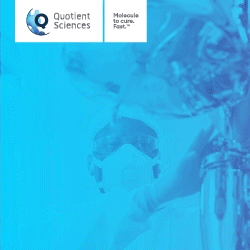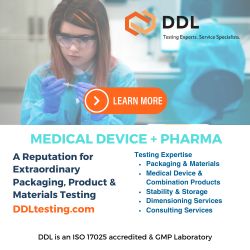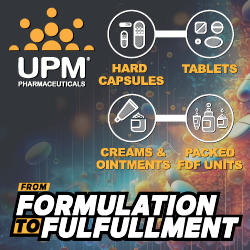Issue:May 2019
TOPICAL DEVELOPMENT - Fast Tracking Your Way to Success
THE RISK CHALLENGE
Recent reviews have suggested that it takes the evaluation of 10,000 compounds to produce one approved medicine containing a new chemical entity (NCE), and the development time is typically between 10 and 14 years with costs in excess of $1 billion.1,2 Nevertheless, the continual discovery of new potential target pathways, the re-purposing of drugs, and advantageous regulation focused on orphan drugs is stimulating companies from the largest multinationals to the smallest single drug biotech startups to continue to invest time, effort, and resource in the development of the next commercially successful drug product. The development strategies taken by these companies can be very different, and a fundamental consideration is their attitude to risk. It is typically dependent on their funding structure and the funds they have available, the markets they are aiming for, their corporate culture as it relates to risk tolerance, and regulatory agencies assessment of the medical need for the product.
This is especially true in the development of any topically applied medicine, in which performance is intimately linked to formulation and the attitude to risk impacts the decision as to whether to develop either a simple Proof of Concept (PoC) prototype formulation or a fully market-ready, commercially viable product early in the development process.
Small single drug biotech companies are typically funded by external investment and must raise large sums of money as they complete specific milestones in their project. These companies will be usually focused on taking their drug candidate into a formulation development program for a single geographic market (eg, EU or US). They will often target the development of a simple or prototype formulation, addressing problems as they arise, so they can evaluate the asset in a preclinical or clinical PoC study within their initial budget. Investors, whether venture capitalists or Big Pharma, are aware of the risks of early drug development and want clear demonstrations of safety and/or efficacy before committing further funds.
The challenge with this approach is that if the early studies are successful, then further development will likely involve reformulation and extensive bridging safety studies. In the worst-case scenario, it can involve starting again because the formulation needed to proceed to final Marketing Authorisation Application (MAA) or New Drug Application (NDA) enabling clinical studies can be radically different from the PoC prototype formulation. The time and money initially saved in the early stages of the project is often lost and/or exceeded later in the project. Any pharma company that is considering in-licensing from or investing in a small biotech start-up, will always factor in the commercial readiness of the formulation into their due diligence process, and the risks of only having a simple PoC formulation will reduce their evaluation value.
Large pharma organisations have detailed processes and procedures for assessing the development risks of their internal pipeline and ensuring that any formulation meets a well-defined quality target product profile (QTPP). They want to ensure it is an optimized, patient-friendly, stable, clinically-safe, commercially viable and approvable, often global market-ready formulation before any preclinical/clinical evaluation. This approach invariably takes longer and requires more investment earlier in the project, but it does significantly reduce the risks of taking a suboptimal, patient unfriendly, and non-commercially viable formulation into the clinic. Any key impacts of formulation on performance, so crucial for a topical product, will have been identified upfront, and this will greatly reduce the chances of making changes later in clinical evaluation when it will be costlier and have a larger impact to the overall development timelines. Furthermore, the risks of having to do bridging studies or even repeat early clinical studies, typical in the order of $5 to $10 million for Phase II trials, are significantly reduced.3
It is likely that significant numbers of “topical therapeutically effective” and commercially viable drugs have had their development stopped because a suboptimal simple formulation did not show the necessary safety and efficacy during the PoC stage of the project when an optimized formulation would have shown otherwise. With the odds so great and upfront investment so high no companies want to be in this situation. Conversely, there are undoubtedly topical products on the market developed by biotech or small pharma companies and subsequently out-licensed to large pharma companies that might easily have been culled because of their risk profile in the early stages of development was less favorable when compared to other candidates in a large company pipeline. Having only a single drug candidate focuses the mind of a small company’s management to “how can we address this risk” rather than “that is a significant risk” and if they hadn’t taken the risk and proceeded into PoC studies, the patient benefits and commercial value needed to justify the investment in money and time would never have been identified.
MINIMISING RISK & MAXIMISING MITIGATION
Leaders in topical product development hold an ethos that evolves around mitigating risks in product development, whatever the financial constraints on the client. These industry experts believe the optimal route to success sits somewhere between the two aforementioned extreme approaches, where it is not a drug alone that is used by a patient but a medicine (Drug Product) that needs to deliver the molecule safely and efficaciously to the site of action in a cost-effective manner. In the case of topicals, this is particularly acute because the residence time for topicals is short, wash-off is inevitable, and patients have a strong preference of what they apply to their skin or other areas of the body. The patient or consumer must always be at the forefront of any development strategy. The cosmetics and aesthetics of the final product are almost as important for a commercially successful product as the product’s efficacy. The selection of a formulation for topical application is influenced by the physicochemical properties of the drug and its potency, the disease to which it is applied, and the patient who will use it (Figure 1).
Irrespective of the budget and a client’s attitude to risk, the gold standard approach to drug product development has always been to follow a risk-based Quality-by-Design (QbD) strategy as recommended by the FDA. Initially, this involves working with the client to develop a QTPP to define the key requirements of the product, considering the quality, safety, and efficacy of the drug product. The QTPP is an evolving document that is updated as the project progresses in which any Critical Quality Attributes influenced by Critical Material Attributes (CMA) and Critical Process Parameters (CPP) are identified, monitored, and/or controlled. In parallel to the evolution of the QTPP, performing a risk assessment is always advocated by industry leaders. This utilizes a Failure Mode and Effects Analysis (FMEA) in which the three criteria of severity, probability, and detectability are used to generate a risk register in which the appropriate proposed mitigation, control measures, and potential contingencies are described. Like the QTPP, this risk assessment document is updated as the program evolves, allowing the client to maintain a state of control over the program. Such an inexpensive process underpins the ongoing development strategy for the client, regulators, and any potential investors.
The preformulation stage of a new drug candidate is considered by industry leaders to be the most critical step for a topical program in which the drug’s physicochemical properties and desired dosage form are considered and upon which the final optimized commercially ready formulation is built. Initially, a stability-indicating analytical method must be developed so an understanding of any potential routes of drug instability can be detected that would cause problems in later stages of the development process. For the development of topical semi-solid drug products, preformulation studies typically involve solubility, stability, and compatibility studies with potential excipients to be used in the final dosage form. Specialist providers perform this work using state-of-the-art automated and robotic systems to improve the efficiency of data generation. These studies enable rational formulation design and generate an understanding of drug solubility and achievable drug concentration as well as any inherent drug instability and any drug/excipient/packaging incompatibilities. If a particular risk has been identified, target screening of any excipients based on internal expertise will be carried out, and researchers will look to provide a solution to mitigate the risk of drug instability at the very start of the project.
The key to this approach is that risks are identified, either in the initial risk assessment or in the pre-formulation, right up front so the potential consequences of these risks to the project can be understood at the earliest possible stage.
The lowest risk approach to any submission is to try and keep to materials, processes, and parameters with which the regulatory authority is familiar. Industry leaders know to advocate the use of approved, and where possible, compendial excipients, in which the type and concentration of excipient used should be acceptable from a regulatory (eg, inactive ingredients database (IID) and disease perspective. Following preformulation, a series of prototype formulations will be developed to meet the formulation criteria defined in the QTPP, including but not limited to dosage form, strength, and packaging type, posology, any desirable aesthetic, organoleptic and/or cosmetic properties, manufacturability, and cost of goods.
For topical products, it is essential the lead (and potentially a back-up formulation depending on any risk factors identified) has been optimized and characterised not only to demonstrate that it will maintain its quality and performance during its life on a pharmacy shelf but also that it is giving the formulation the best chance of measurable success in the clinical setting.
Throughout the years, newly developed formulations include the incorporation of a variety of proprietary and automated systems and instrumentation (Figure 2) to evaluate the future potential physical and chemical stabilities of any formulation and thus identify the risk of a product’s quality, changing over the required shelf-life. For example, instrumentation like the LUMiFuge® have been introduced to predict the risk of any potential longer-term formulation physical stability issues and provide a tool to determine how they can be addressed.

Key leaders in the field have a large toolbox of performance testing models ranging from simplistic models used to select the optimized thermodynamics and release of actives from the formulations (in vitro release testing (IVRT) to skin models of drug permeation and penetration through to complex ex vivo human skin disease models involving local infections and inflammatory responses associated with these infections or pathway specific stimulation (eg, psoriasis, atopic dermatitis, acne, etc).
These models, which continue to grow in sophistication as more becomes known about molecular biology, are transforming the risk profile of the development process for topical formulations. Senior industry professionals use these models to better understand the behavior of the active drug and de-risk the formulation development process. Excellent correlations have been established between these proprietary models and the clinic, and they also help future investors or R&D management clearly understand the risks prior to authorizing expensive clinical trials.4
A STRATEGY FOR SUCCESS
Fundamentally, this unique approach forces a rigorous analysis of the product requirements and the risks associated with the development upfront so likely issues can be prevented before they happen. The development approach builds the formulation up from sound foundations and crucially focuses on the physical and chemical requirements and the biological challenge. The costs are small compared to running a clinical trial, and the time required does not have to include any repeated steps.
This method has proved successful for specialist contract providers and their clients. Confidence in this method is demonstrated by the increase in approved topical NDAs throughout the past decade when development has involved this unique approach. Interestingly, this approach does not end up being materially more expensive or of longer duration when the development process (ie, pre-formulation, formulation development, and performance testing experiments) is appropriately designed and conducted in parallel when compared to the simple PoC approach in which a small biotech start-up initially may feel forced to consider.
The discussed “accelerated” approach addresses and provides almost immediate solutions to many of the issues highlighted previously and provides clients with confidence that their chances of success are maximized. It also provides a robust data package to allow potential investors or large pharma in-licensing teams to perform due diligence and make informed decisions about the product and its future life cycle management.
REFERENCES
- Sullivan T. A Tough Road: Cost To Develop One New Drug Is $2.6 Billion; Approval Rate for Drugs Entering Clinical Development is Less Than 12% [Internet]. Policy & Medicine. 2018 [cited 1 February 2019]. Available from: https://www.policymed.com/2014/12/a-tough-road-costto-develop-one-new-drug-is-26-billion-approval-rate-for-drugsentering-clinical-de.html.
- Sertkaya A; Wong H. H.; Jessup, A; Beleche, T (2016). Key cost drivers of pharmaceutical clinical trials in the United States. Clinical Trials. 13 (2): 117–26. doi:10.1177/1740774515625964. PMID 26908540.
- Martinez J. Driving Drug Innovation and Market Access: Part 1-Clinical Trial Cost Breakdown | Center Point Clinical Services [Internet]. Centerpointclinicalservices.com. 2016 [cited 3 February 2019]. Available from: https://www.centerpointclinicalservices.com/blog-posts/driving-drive-drug-innovation-and-market-access-part-1-clinical-trial-cost-breakdown/.
- L. Ring, J. Neil, A. Brink, K. Powell, J. Volmer, J. Lenn, M.B. Brown. Comparison of ex-vivo human skin model of Th2 driven inflammation as a preclinical model of acute atopic dermatitis. [poster]. Presented at AAPS Pharm Sci.
To view this issue and all back issues online, please visit www.drug-dev.com.

Prof. Marc Brown is Cofounder and Chief Scientific Officer of MedPharm. He has been the guiding force behind all of MedPharm’s scientific developments and intellectual property. He has been Professor of Pharmaceutics in the School of Pharmacy, University of Hertfordshire since 2006 and has visiting/honorary professorships at the Universities of Reading and King’s College London. He has over 200 publications and 26 patents describing his work. His research interests lie mainly in drug delivery to the skin, nail, and airways. To date, he has been involved in the pharmaceutical development of over 50 products that are now on the market in Europe, America, and Japan. Prior to MedPharm, he was an academic in the Pharmacy Department at KCL.

Dr. Jon Lenn is Chief Technology Officer at MedPharm, with direct responsibility for MedPharm’s operations in the United States based out of Durham, NC. Since joining in 2015, he has led MedPharm’s development of cutting-edge performance models for assessing penetration and activity of clients’ products targeted toward key biochemical pathways. He has over 15 years of experience in developing dermatological projects with Connetics, Stiefel, and GSK, and has been directly involved with the development and approval of 8 products. He earned his PhD on the topical delivery of macromolecules from the University of Reading.

Dr. Jeremy Drummond is Senior VP, Business Development, at MedPharm. He has spent over 20 years leading the commercial supply of product and services to pharmaceutical companies across the globe. He is responsible for leading revenue growth, key client relationships, and marketing MedPharm to its global customer base. He started his career as a technical formulator and earned his PhD in Organic Chemistry from the University of Cambridge.
Total Page Views: 9423














